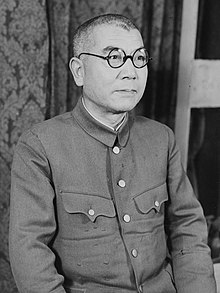Akira Mutō (武藤 章, Mutō Akira, 15 December 1892 – 23 December 1948) was a general in the Imperial Japanese Army during World War II. He was convicted of war crimes and was executed by hanging. Mutō was implicated in both the Nanjing Massacre and the Manila massacre.
Akira Mutō | |
|---|---|
 Mutō in 1947 | |
| Born | 15 December 1892 Hakusui, (present day of Minamiaso, Kumamoto) Japan |
| Died | 23 December 1948 (aged 56) |
| Cause of death | Execution by hanging |
| Criminal status | Executed |
| Conviction(s) | Crimes against peace War crimes |
| Trial | International Military Tribunal for the Far East |
| Criminal penalty | Death |
| Military career | |
| Allegiance | |
| Service | |
| Years of service | 1913–1945 |
| Rank | |
| Commands | Imperial Guards Division |
| Battles / wars | Second Sino-Japanese War World War II |
Biography
editThis section needs additional citations for verification. (June 2017) |
Mutō was a native of Hakusui, Kumamoto, and a graduate of the 25th class of the Imperial Japanese Army Academy in 1913. He graduated from the 32nd class of the Army Staff College in 1920. Mutō was assigned as a military attaché to Germany from 1923 to 1926. On his return to Japan, he served in various administrative and staff positions within the Imperial Army General Staff Office.
Mutō was on the strategic planning staff of the General Staff Office in 1935, and was chief of the military intelligence section of the Kwantung Army at the time of the Marco Polo Bridge Incident. He is believed to have been one of the planners behind the incident which sparked the Second Sino-Japanese War.[1][2]
Promoted to Vice Chief of Staff of the Japanese Central China Area Army, Mutō was in China for many of the initial campaigns of the conflict, and was later charged with having led troops during the worst excesses of the Nanjing Massacre. Mutō was recalled to Japan in 1939, promoted to major general in 1939, and served on the Military Affairs Bureau of the Ministry of War.[citation needed]
Promoted to lieutenant general just prior to the start of the Pacific War, Mutō served as director of the Military Affairs Bureau at the time of the attack on Pearl Harbor. He was assigned command of the Second Imperial Guards Division at Singapore in April 1942. He was later assigned to command Japanese forces on Sumatra in Japanese -occupied Netherlands East Indies from June 1944, and was transferred to the Philippines in October 1944, where he was appointed chief of staff of the Japanese Fourteenth Area Army under General Tomoyuki Yamashita.[3]
He was accused of having conducted a campaign of slaughter, torture and other atrocities against the Filipino civilian population, prisoners of war and civilian internees,[4] and by ordering guerrilla containment.
After the surrender of Japan, Mutō was arrested by the American occupation authorities and charged with war crimes before the International Military Tribunal for the Far East. He was convicted for atrocities against civilians and prisoners of war in both China and the Philippines, and was executed by hanging on 23 December 1948.[5]
References
editBooks
edit- Fuller, Richard (1992). Shokan: Hirohito's Samurai. London: Arms and Armor. ISBN 1-85409-151-4.
External links
edit- Ammenthorp, Steen. "Ushiroku, Jun". The Generals of World War II.
- Budge, Kent. "Muto, Akira". Pacific War Online Encyclopedia.
- Chen, Peter. "Muto, Akira". WW2 Database.
Notes
edit- ^ "WAR RESPONSIBILITY—delving into the past (2)/Konoe, Hirota sat on their hands". Yomiuri Shimbun. 13 August 2006. Archived from the original on 17 March 2013. Retrieved 21 November 2008.
- ^ Reiji Yoshida (12 August 2006). "Yasukuni gripes still dog nation". The Japan Times.
- ^ Ammenthorp, The Generals of World War II
- ^ "Trial Watch: Akira Muto". Archived from the original on 28 May 2007. Retrieved 1 October 2007.
- ^ Klip, Andre (2001). Annotated Leading Cases of International Criminal Tribunals. Intersentia nv. ISBN 9789050951418. Retrieved 1 October 2007.